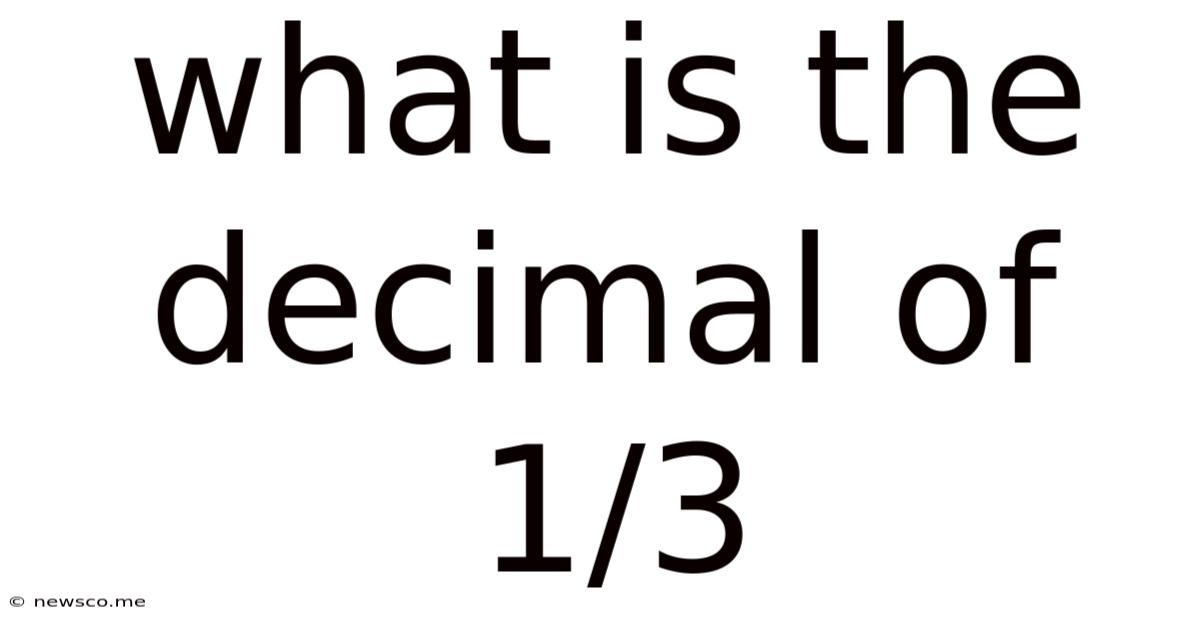What Is The Decimal Of 1/3
News Co
Mar 28, 2025 · 4 min read

Table of Contents
What is the Decimal of 1/3? Unpacking a Seemingly Simple Fraction
The question "What is the decimal of 1/3?" appears deceptively simple. It's a basic fraction, taught in elementary school. However, a deeper dive reveals fascinating insights into the nature of numbers, decimal representation, and the limitations of expressing certain rational numbers as finite decimals. This exploration will delve into the intricacies of this seemingly straightforward problem, examining its mathematical underpinnings, practical applications, and the broader implications it holds within the realm of mathematics.
Understanding Fractions and Decimals
Before delving into the specifics of 1/3, let's establish a foundational understanding of fractions and decimals. A fraction represents a part of a whole, expressed as a ratio of two integers: a numerator (the top number) and a denominator (the bottom number). For instance, in the fraction 1/3, 1 is the numerator and 3 is the denominator. This indicates one part out of three equal parts.
A decimal, on the other hand, represents a number using a base-ten system. It uses a decimal point to separate the whole number part from the fractional part. Each digit to the right of the decimal point represents a power of ten (tenths, hundredths, thousandths, and so on). For example, 0.5 represents five-tenths, or 5/10.
The relationship between fractions and decimals is that they both represent numerical quantities. Any fraction can be converted into a decimal, and vice-versa, although the resulting decimal may be finite (terminating) or infinite (non-terminating).
Calculating the Decimal Representation of 1/3
To find the decimal equivalent of 1/3, we perform long division: we divide the numerator (1) by the denominator (3).
1 ÷ 3 = ?
The process looks like this:
0.333...
3 | 1.000
-0.9
0.10
-0.09
0.010
-0.009
0.001...
As we can see, the division process continues indefinitely. We get a repeating decimal: 0.333... The three repeats endlessly. This is represented mathematically as 0.<u>3</u>. The bar above the 3 indicates the repeating digit.
Why is it a Repeating Decimal?
The reason 1/3 results in a repeating decimal lies in the nature of the denominator, 3. The decimal system is based on powers of 10 (10, 100, 1000, etc.). The prime factorization of 10 is 2 x 5. If a fraction's denominator contains only prime factors of 2 and/or 5, or only factors of 2 and 5, it will have a terminating decimal representation. Since 3 is a prime number and not a factor of 10, the division will never terminate; it produces a repeating decimal.
Exploring Other Repeating Decimals
Many fractions result in repeating decimals. For example:
- 1/7 = 0.<u>142857</u> (the digits 142857 repeat endlessly)
- 2/9 = 0.<u>2</u>
- 5/11 = 0.<u>45</u>
These repeating patterns demonstrate the limitations of representing rational numbers (fractions) precisely using a finite number of decimal places.
Practical Applications and Implications
While seemingly theoretical, the concept of repeating decimals has practical applications in various fields:
-
Engineering and Physics: Precise calculations often require the use of fractions, and understanding repeating decimals ensures accurate results, even if it necessitates working with infinite series.
-
Computer Science: Representing and manipulating fractions and decimals within computer systems requires careful consideration of precision and potential rounding errors, especially when dealing with repeating decimals. Algorithms are designed to handle these issues efficiently.
-
Finance and Accounting: Currency exchange rates often involve fractions and decimals, and the accuracy of calculations is crucial. Understanding repeating decimals helps in minimizing errors in financial transactions.
Rounding and Approximation
In practical applications, we often need to approximate repeating decimals to a certain number of decimal places. Rounding 1/3 to two decimal places gives us 0.33. Rounding to three decimal places gives 0.333, and so on. The accuracy of the approximation depends on the required level of precision for the specific task. The inherent error introduced by rounding should always be considered.
The Mathematical Beauty of Irrational Numbers
Interestingly, while 1/3 is a rational number (it can be expressed as a fraction), its decimal representation is infinite. This highlights a distinction between rational and irrational numbers. Irrational numbers cannot be expressed as a simple fraction, and their decimal representations are both infinite and non-repeating. Famous examples include pi (π) and the square root of 2 (√2).
Understanding the decimal representation of 1/3 provides a gateway to grasping the richer landscape of number systems and their properties. It’s a simple fraction that unveils profound mathematical concepts.
Conclusion: Beyond the Simple Answer
The seemingly straightforward answer to "What is the decimal of 1/3?" is not just 0.333... but a gateway to a deeper understanding of the relationship between fractions and decimals, the limitations of finite decimal representations, and the fascinating properties of rational and irrational numbers. The concept extends far beyond elementary school arithmetic, playing a vital role in numerous fields demanding precision and accuracy. While a simple approximation may suffice for some tasks, appreciating the infinite nature of the decimal representation of 1/3 underscores the beauty and complexity inherent in the world of mathematics. The seemingly simple question opens doors to a wealth of mathematical exploration and understanding.
Latest Posts
Related Post
Thank you for visiting our website which covers about What Is The Decimal Of 1/3 . We hope the information provided has been useful to you. Feel free to contact us if you have any questions or need further assistance. See you next time and don't miss to bookmark.